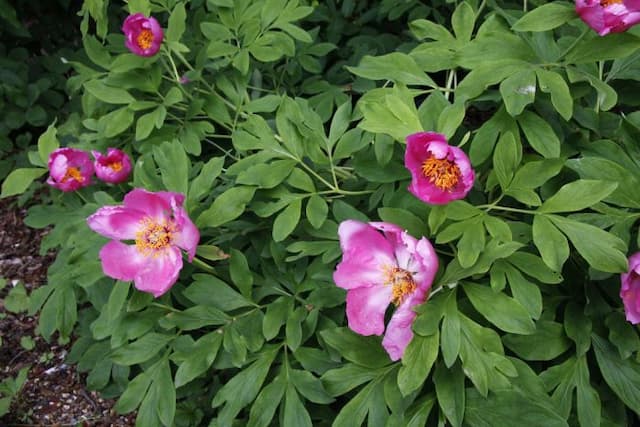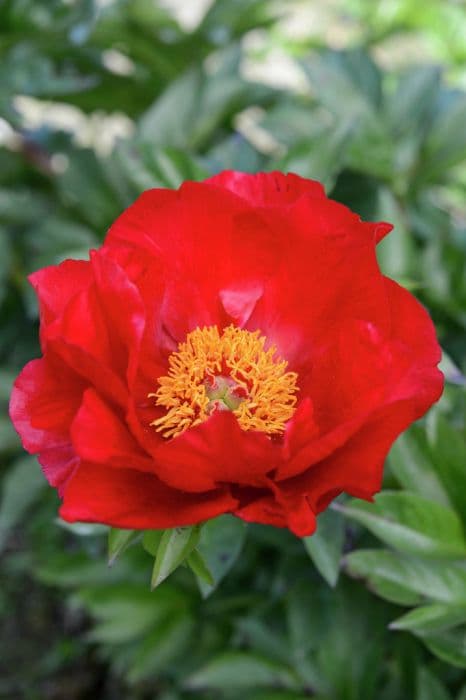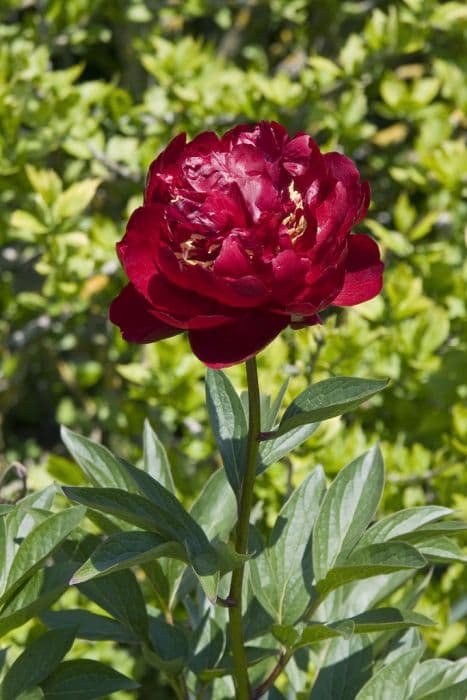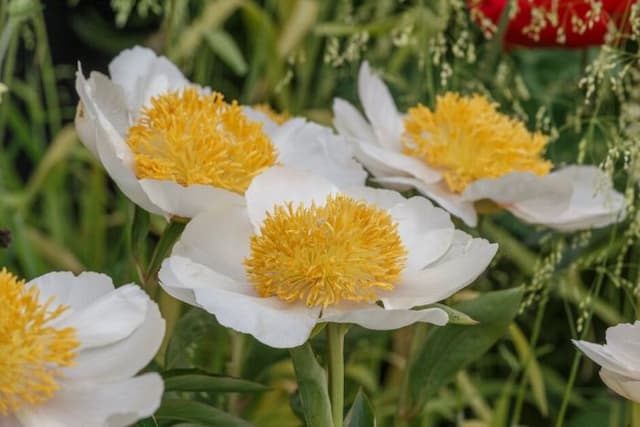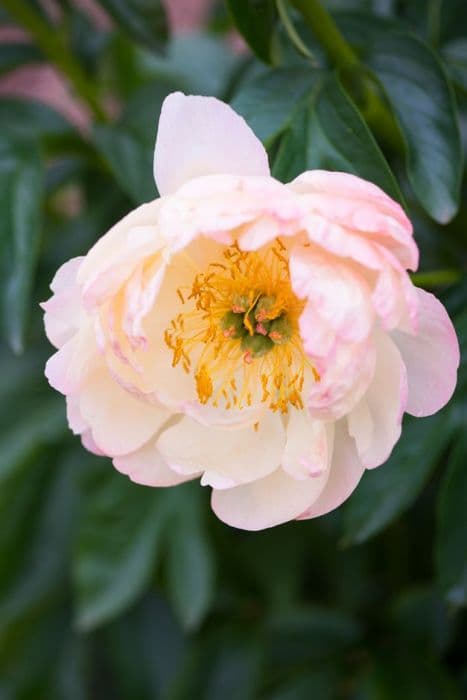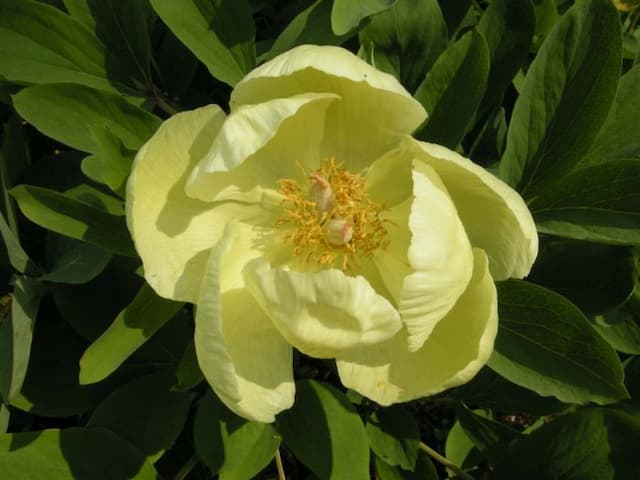Tree peony Paeonia delavayi (S)

ABOUT
Paeonia delavayi, commonly known as the tree peony, is a species of flowering plant that boasts a remarkable aesthetic. It has a woody structure, which distinguishes it from herbaceous peonies that die back to the ground each winter. The stems of the tree peony are permanent, offering a robust framework for its foliage and flowers. The leaves of this plant are typically dark green, divided into multiple leaflets with a somewhat leathery texture. They are arranged in a spiral pattern along the stems, providing a lush, dense appearance that serves as an attractive backdrop for its blooms. The flowers are the most striking feature of the tree peony. They emerge in late spring to early summer, presenting a spectacular display of color. Typically, the blooms are large and bowl-shaped, featuring a ruffled array of petals that can showcase a variety of colors, often with a deep, rich burgundy or red hue at the base that fades to softer yellows or creamy tones towards the petal edges. At the center of each bloom is a group of bright yellow stamens, which adds to the visual appeal and helps to attract pollinators. Tree peonies are known for their delicate fragrance, which emanates from the blooms and can perfume the surrounding air, enriching the sensory experience of the garden. The overall appearance of the tree peony is one of classic elegance, with a natural yet sophisticated presence that can serve as a focal point in various landscape settings.
About this plant
 Names
NamesFamily
Paeoniaceae.
Synonyms
Delavay's Peony, Delavay Peony, Tree Peony, Chinese Tree Peony.
Common names
Paeonia lutea var. delavayi, Paeonia delavayi var. delavayi, Paeonia forrestii, Paeonia delavayi subsp. delavayi, Paeonia potaninii
 Toxicity
ToxicityTo humans
Paeonia delavayi, commonly known as the Tree Peony, is not typically considered toxic to humans. However, as with many plants, it could potentially cause gastrointestinal discomfort if ingested in large amounts due to the presence of compounds such as glycosides. Symptoms may include nausea, vomiting, or diarrhea. It's always prudent to avoid ingesting parts of ornamental plants due to the potential for adverse reactions.
To pets
The Tree Peony (Paeonia delavayi) is also not known to be toxic to pets. Although it isn't specifically listed as toxic, it's still wise to prevent pets from ingesting plants as a general precautionary measure. If a pet does consume parts of the Tree Peony, gastrointestinal upset, such as vomiting or diarrhea, might occur, typically if large amounts are ingested. If you suspect your pet has ingested a significant quantity or is showing symptoms of distress, it is advisable to consult a veterinarian.
 Characteristics
CharacteristicsLife cycle
Perennials
Foliage type
Deciduous
Color of leaves
Green
Flower color
Red
Height
4 feet [1.2 meters]
Spread
4 feet [1.2 meters]
Plant type
Shrub
Hardiness zones
6
Native area
China
Benefits
 General Benefits
General Benefits- Aesthetic Appeal: Paeonia delavayi, commonly known as Tree Peony, has large, attractive flowers that enhance the beauty of any garden.
- Diversity in Landscaping: Tree Peonies offer a variety of colors and forms, providing diverse options for landscape design.
- Seasonal Interest: With their vibrant, early-summer blooms, Tree Peonies add color to gardens when many other plants are not yet in flower.
- Longevity: Tree Peonies are known for their long life span, often living for decades and providing lasting enjoyment.
- Drought Tolerance: Once established, Tree Peonies can tolerate drought, making them appropriate for water-conservative gardens.
- Cold Hardiness: Tree Peonies are capable of withstanding cold winters, making them suitable for a variety of climates.
 Medical Properties
Medical Properties- Anti-inflammatory: Paeonia delavayi is said to contain compounds that may help reduce inflammation in the body.
- Antispasmodic: It is reportedly used in traditional medicine to relieve muscle spasms.
- Analgesic: Paeonia delavayi may have properties that help alleviate pain, making it potentially useful in pain management.
- Immunomodulatory: There are claims that it might modulate the immune system, though details on this are sparse and need scientific validation.
- Antioxidant: The plant is believed to contain antioxidants, which can help in preventing cell damage caused by free radicals.
 Air-purifying Qualities
Air-purifying QualitiesThis plant is not specifically known for air purifying qualities.
 Other Uses
Other Uses- Paeonia delavayi, commonly known as tree peony, can be used as a source of yellow dye for textiles, obtained from its petals.
- The seeds of the tree peony are sometimes used in traditional crafts for making natural jewelry or decorative art pieces.
- Florists may use the dried seed pods of tree peony in flower arrangements for their unique shape and texture.
- Tree peony is occasionally planted for soil stabilization and erosion control due to its robust root system.
- The wood of tree peony is sometimes carved into small ornamental objects or used in woodworking for inlay work.
- Landscapes benefit from the use of tree peony as it acts as a natural habitat for beneficial insects and birds.
- Practitioners of feng shui may plant tree peony in gardens to attract positive energy and create a sense of balance.
- Tree peony's large, showy flowers are commonly used in splashy, artistic photography for their dramatic effect.
- The plant is used in wedding ceremonies for decor due to its association with prosperity, happiness, and the vibrant colors of the flowers.
- Gardeners sometimes cultivate tree peony as a companion plant to roses, as it's believed to enhance the growth and vitality of the roses.
Interesting Facts
 Feng Shui
Feng ShuiThe Tree peony is not used in Feng Shui practice.
 Zodiac Sign Compitability
Zodiac Sign CompitabilityThe Tree peony is not used in astrology practice.
 Plant Symbolism
Plant Symbolism- Prosperity: The Peony is often associated with wealth and honor, especially in Eastern cultures. It's considered a good omen for financial success.
- Beauty: With its large, lush blooms, Peonies are a symbol of beauty and are often used to represent the feminine ideal.
- Romance: The Peony is linked to the myth of Paeon, a student of Asclepius, the Greek god of medicine, who was saved by Zeus and turned into a peony flower. Thus, it carries connotations of love, affection, and bashful romance.
- Honor: Especially in China, the Peony is known as the "king of flowers" and signifies honor and the high value placed on beauty and creativity.
- Happy Marriage: Due to their lush and full-bodied blooms, Peonies are used in wedding bouquets and decorations to symbolize a happy marriage full of love and prosperity.
- Compassion: Peonies' tendency to bloom in the spring associates them with renewal and compassion, as they bring color back into the world after winter's paleness.
 Water
WaterThe Tree Peony should be watered deeply once a week, providing enough water to moisten the soil to a depth of about 12 inches. During hot or dry periods, increase the frequency to twice per week, ensuring each time about 1 to 1.5 gallons of water is applied to support its root system. Reduce watering in the fall as the plant prepares for dormancy, and during the winter, water sparingly, only if the soil is dry to the touch. Over-watering can lead to root rot, so it is crucial to allow the soil to dry out slightly between watering sessions.
 Light
LightThe Tree Peony thrives in full sun to partial shade, requiring at least six hours of sunlight each day. An ideal spot would be one that enjoys morning sun and afternoon shade, especially in hotter climates, to protect the blossoms from fading. However, too much shade can lead to leggy growth and fewer flowers, so always ensure there is ample light.
 Temperature
TemperatureTree Peonies prefer a temperature range between 50 and 75 degrees Fahrenheit but are cold hardy and can withstand winter temperatures down to -20 degrees Fahrenheit. They enjoy cooler night temperatures, which can help to promote healthy bud development. Ideally, they should not be subjected to abrupt temperature swings or prolonged exposure to temperatures above 80 degrees Fahrenheit to avoid heat stress.
 Pruning
PruningThe Tree Peony benefits from pruning to remove dead or damaged wood, which should be done in late winter or early spring before new growth starts. Prune just above a strong bud to encourage branching. Additionally, after flowering, deadheading spent blooms can promote plant health, but leave seed pods if you desire them for visual interest or to collect seeds. Pruning is not typically needed for shaping, as Tree Peonies naturally form a pleasing structure.
 Cleaning
CleaningAs needed
 Soil
SoilTree Peony thrives in well-drained, nutrient-rich loamy soil with a pH of 6.5-7.0. A mix of two parts garden soil, one part well-rotted manure or compost, and one part perlite or coarse sand is ideal to ensure good drainage and fertility.
 Repotting
RepottingTree Peony does not need frequent repotting as it is a slow grower; repot every 3 to 5 years, or when the plant outgrows its container.
 Humidity & Misting
Humidity & MistingTree Peony prefers average humidity levels but is quite adaptable and does not need specific humidity adjustments when grown outdoors in its preferred environment.
 Suitable locations
Suitable locationsIndoor
Ensure bright light, cool temps, and well-draining soil for indoor Tree Peonies.
Outdoor
Plant in sun to part shade, protect from strong winds, ensure soil is well-draining.
Hardiness zone
5-9 USDA
 Life cycle
Life cyclePaeonia delavayi, commonly known as the Chinese peony or Delavay's peony, begins its life cycle with seed germination, which can be slow and may require a period of cold stratification to break dormancy. Once germinated, the plant develops a root system and a shoot that emerges from the soil as a single stem. The stem grows leaves that are deeply lobed, and the plant enters a vegetative state where it focuses on growth and energy storage in its roots. In spring to early summer, after several years of vegetative growth, it produces large, showy flowers that range from red to maroon, which are pollinated by insects such as bees. Following pollination, the plant forms seed pods that mature by late summer and, upon ripening, release seeds. After seed dispersal, the plant enters a period of dormancy during the winter months, conserving energy in its roots for the next growing season.
 Propogation
PropogationPropogation time
Spring to Summer
Propogation: Paeonia delavayi, commonly known as the tree peony, can be propagated by seed or by grafting, with grafting being the more popular method. To propagate by grafting, in late summer or early fall, a stem from a healthy tree peony is cut and joined to a rootstock of a herbaceous peony. The graft union is then buried below the soil surface to allow the stem piece, or scion, to unite and grow from the rootstock. This method accelerates the growth and flowering process as compared to growing from seed, which can take several years before the plant blooms. Grafting also allows the specific variety of tree peony to be reliably reproduced, preserving its unique characteristics.
